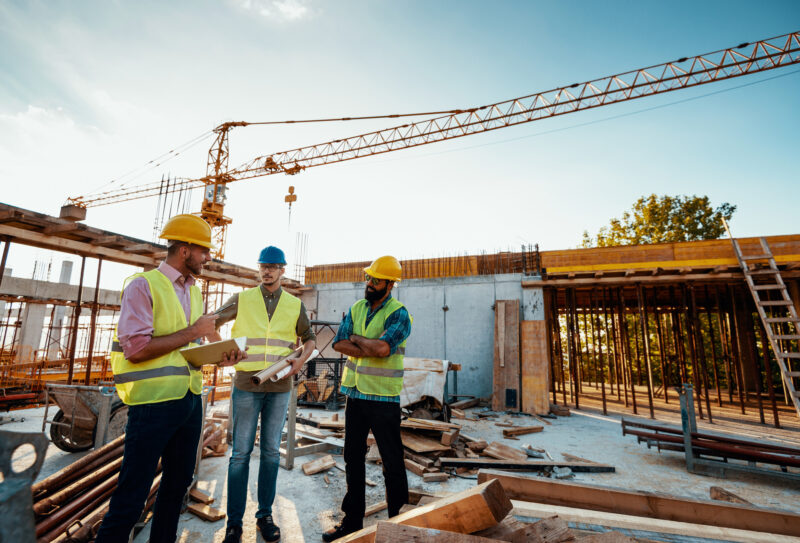Commercial construction can be a daunting task, but it doesn’t have to be. With the right knowledge and planning, you can overcome many of the common challenges that come up during a project. In this article, we will provide tips and solutions for overcoming these obstacles so that your commercial construction project runs smoothly and successfully.
Identifying Project Risks and Mitigation Strategies
When it comes to commercial construction projects, identifying potential risks and developing mitigation strategies is essential for success. From budget concerns to impacts on the environment or local community, a variety of issues can arise throughout the building process. It’s up to those involved in the project to be proactive, keeping an eye out for potential pitfalls before they become bigger problems down the line.
One important factor that should be taken into account is ensuring accurate cost estimates are made at all stages of development – from initial planning through completion and beyond. Inaccurate projections can lead to unforeseen expenses and delays, potentially leading to cost overruns or other complications that could have been avoided with better preparation beforehand. Additionally, changes in external conditions such as weather patterns or economic fluctuations should also be accounted for when considering risk factors associated with any given project. Another key element in mitigating risk is understanding the requirements for permits and regulatory compliance related to any given project before work starts.
This includes making sure all required paperwork has been filed correctly – including zoning regulations and any environmental protection guidelines unique to each locale – so as not to run afoul of laws governing construction activities within a particular jurisdiction. Doing this early on helps ensure that things don’t get held up later due to unexpected snags caused by missed steps during planning stages earlier on in the process.
Finally, having clear communication between parties involved throughout every step of commercial construction projects will help identify possible problems quickly while allowing for solutions tailored specifically addressing them without unnecessary delays or added expense due to unforeseen matters arising further along in development cycles than expected had proper collaboration between stakeholders not occurred ahead of time. By taking these proactive measures from start to finish, completing complex builds efficiently becomes much more manageable no matter how challenging existing variables may appear initially
Effective Resource Allocation and Scheduling

Resource allocation and scheduling are two of the most important factors in commercial construction, as they can significantly impact cost, timeline, and productivity. To ensure successful projects, it is essential to allocate resources properly and create an efficient schedule. However, this can often be a difficult task due to unforeseen circumstances or miscommunication between stakeholders. To facilitate better resource distribution and scheduling processes, businesses should strive for clear communication with all parties involved including contractors and suppliers. It is also important to have tools in place that allow for quick updates when changes occur to keep the project on track.
Additionally, having a contingency plan ready will help address any unexpected delays or issues that may arise during construction. Furthermore, automation technology offers companies powerful solutions for managing workflow operations such as resource planning or tracking progress against timelines. This type of technology ensures accurate data collection which enables managers to make informed decisions regarding budgeting or resourcing needs throughout the project’s lifespan without overspending time or money on unnecessary tasks.
Finally, having an experienced team who understands how different components interact with each other is key to effective resource allocation and scheduling processes within commercial construction projects. Hiring professionals who understand industry best practices can result in fewer problems down the line while ensuring optimal results from start-to-finish
Managing Change Orders and Minimizing Cost Overruns
Managing change orders and minimizing cost overruns are two of the most common challenges faced in commercial construction. To overcome them, contractors should create a comprehensive budget that includes line items for all potential changes to account for any unforeseen costs. This will give a more accurate estimate of the total cost at the start of the project. Additionally, a detailed timeline should be established with specific deadlines for both contractor and client-side deliverables to keep projects on track and avoid delays or additional expenses caused by rework.
Strictly adhering to this plan and maintaining effective communication between all parties involved is essential to minimize disruption from change orders while still delivering quality results within budget constraints. For more information on managing construction projects and best practices for minimizing cost overruns, be sure to check out the BuildOps Commercial Construction Technology Glossary. This comprehensive guide provides definitions and explanations for key concepts and tools used in modern commercial construction projects.
From project management methodologies to cost estimation techniques, this glossary covers it all. Whether you’re a construction professional or just starting out in the industry, the BuildOps Commercial Construction Technology Glossary is an essential tool for staying up-to-date on the latest trends and best practices.
Ensuring Quality Assurance Throughout the Process

Ensuring quality assurance throughout the process of commercial construction is a necessity for any successful project. From design to completion, attention must be paid to every detail to guarantee that all specifications are met and no problems arise during or after the completion of the job.
To ensure quality control, it’s important to have robust systems and processes in place from the very beginning. This includes having an experienced leader who is familiar with industry standards and can serve as a point person for approval purposes before materials are purchased or workers are hired. Additionally, regular inspections should be done on-site by highly qualified personnel to swiftly identify issues that need addressing before they become bigger problems down the line.
An effective system will also involve setting realistic expectations with suppliers about delivery times, ensuring adherence to safety regulations at all times, and tracking progress against timelines so potential delays are identified early enough for corrective actions to take place if needed. All these steps combined will help make sure that when your commercial construction project reaches its completion date, youre certain it was built according to plan without compromising on safety or quality standards along the way.


